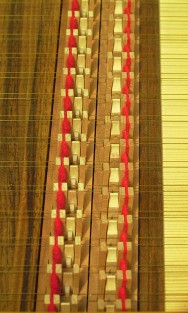Technical Library
ACTION II: The action in the instrument
Entire Contents Copyright © 2010 CBHTechnical LibraryACTION II: The action in the instrument Entire Contents Copyright © 2010 CBH |
 |
| Action of the Neapolitan harpsichord |
The
action in the instrument…
This photo shows the action of the Neapolitan harpsichord,
viewed from the treble (cheek) side of the instrument with the jackrail removed.
There are two choirs of strings, named according to their pitch in organ terminology,
and their proximity to the player. The front 8´ jacks—shown on the
left—are the closest to the player, and face towards the treble of the
instrument. The back 8´ jacks face towards the bass (spine). You would
expect the back 8´ to have a round, plain tone because the strings are
plucked closer to their middle, the front 8´ reedier or even nasal.
Each choir can be brought into operation by moving its register to the ON position, engaging all the quills of that choir under the strings so they are ready to pluck, or putting them “out of gear”, sliding the register to the OFF position so the quills just clear the strings, even if the notes are played.
The registers in this instrument can be moved with a finger. Larger harpsichords can have their registration changed by either having the stop registers pierce the cheek, like in the Ruckers Single, or by the provision of stoplevers either on the wrestplank, or—bringing them closer for convenience of the player—penetrating the nameboard like on the French Double.
No matter how the registers are mechanically changed, the ON and OFF positions are critical to the correct operation of the instrument, and must be precisely set.
| Technical Library overview | |
| Harpsichords Australia Home Page |